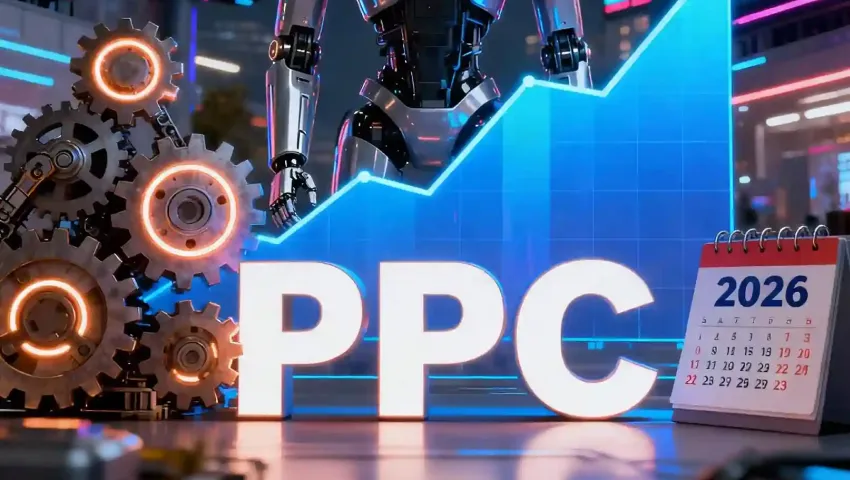Paid search is entering a new era. 2026 is around the corner, and the convergence of artificial intelligence and automation is shaping how pay-per-click (PPC) campaigns are managed, measured and optimized. Advertisers must adapt if they want to maintain visibility, control and performance in a world where platforms increasingly take the wheel.
1. The Rise of AI-First Campaigns
AI has moved from optional tools to foundational components of PPC. Campaign types like “performance max” or equivalent consolidated formats now dominate many major ad platforms. This means that specific keyword bids, precise match types and micro-budget adjustments are becoming less common.
What this means for you:
- You need to trust the automated engine but you also need to feed it the right signals. If your conversion tracking is messy or incomplete, the AI may optimise toward the wrong outcome.
- Manual oversight remains critical. While AI can handle scale and speed, the human role shifts toward strategy: defining business goals, refining audience signals and creative inputs.
- The differentiator will be the quality of your inputs your data, your creatives and your audience definitions not just the fact you are using automation.
2. Changing Definition of Control
With automation taking more responsibility for creative and bidding decisions, “control” is no longer about tweaking individual keywords. Instead control means setting clear objectives, providing accurate conversion data and overseeing the strategy.
Key take-aways:
- You may no longer be able to see every search term, every bid change or every audience selection, but you can still guide the machine by your inputs: clear goals, clean conversion tracking, strong creative assets.
- The human marketer’s role is shifting from operator to curator and strategist. Your job becomes choosing which campaigns to automate, which to keep manual, and ensuring the machine is optimising toward the right outcomes.
- If you rely too heavily on old paradigms (manual bids, isolated keywords, granular controls) you risk being left behind. Adaptation is required.
3. Measurement & Attribution in Flux
As PPC platforms incorporate more automation, less transparency often follows. Search-term reports become less detailed, placement data is modelled rather than fully disclosed, and attribution paths become more complex.
What practitioners are doing:
- Focus on first-party data and conversion events that truly tie to business outcomes rather than just platform-reported metrics.
- Use broader measurement frameworks like media mix modelling, lift testing and value-based conversions rather than just CPA or clicks.
- Accept that uncertainty is part of the ecosystem: instead of aiming for perfect data, aim for reliable enough data plus consistent testing and learning.
4. Creative & Asset Depth Become Competitive Levers
When automation handles bidding, placement and audience selection, creative assets become one of the primary ways to stand out. With many advertisers plugged into the same automated systems, how you feed the machine matters.
Best practices include:
- Create a rich library of assets: headlines, longer copy, videos, images, feed-based variations and brand-specific creative that the system can test and rotate.
- Maintain brand voice, compliance and nuance where automation can’t. In industries with heavy regulation or strong brand identity, human oversight in creative is non-negotiable.
- Use automation for scale (variations, testing) but human judgement for brand consistency, messaging strategy and structural reviews.
5. Visibility is Harder but Opportunity Still Exists
Rising competition and automation don’t mean the end of PPC they mean the nature of visibility is shifting. Click volumes may drop, costs may rise, but advertisers who align with the new rules can still win.
Strategic shifts to consider:
- Focus on high-intent queries and audiences. As generic clicks get more contested, targeting becomes more about who and when, not just what keyword.
- Diversify platforms and channel mix. Relying solely on one network places you at risk; using multiple networks and formats helps you capture varied demand.
- Reframe KPIs: Instead of pure ROAS by campaign, think lifetime value (LTV), incremental profit, and multi-touch contribution.
- Invest in brand and story. Automation amplifies what you feed it so building differentiation through brand presence, trust and repeat behaviour pays off.
Final Thoughts – PPC Trends
The PPC Trends of 2026 isn’t just about new features or platforms it’s about a shift in how campaigns are managed, measured and scaled. AI and automation are no longer optional extras they shape the game. But human strategy, data integrity and creative + brand recognition still win.
If you prepare now by refining your tracking, creating strong creative assets, thinking beyond clicks and embracing automation thoughtfully you won’t just survive the fight for visibility you’ll lead it.

